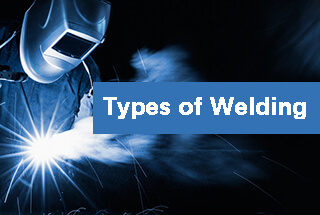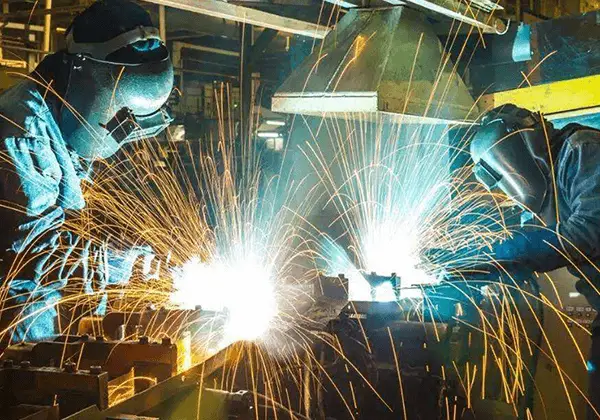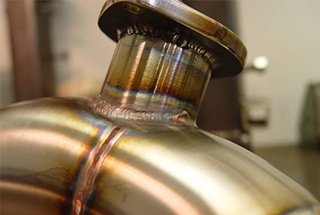
1. What is welding power supply?
In an electric welding machine, the device that provides the necessary electrical energy for welding and possesses electrical characteristics suitable for the task is referred to as a welding power supply.
2. When the arc length changes, the arc voltage will also change?
The arc voltage in arc welding is determined by the external characteristics of the arc welding power source. The longer the arc, the higher the arc voltage, and the shorter the arc, the lower the arc voltage.
3. During CO2 welding, when the extension length of the welding wire changes, the current display value will also change?
The longer the extension length of welding wire (i.e. dry extension length), the higher the resistance of the wire, which leads to a greater consumption of current for resistance heat, resulting in a lower displayed value of welding current and a reduced actual welding current.
To mitigate these effects, the extension length of welding wire is typically set within a range of 12-20mm.
4. When CO2 / MAG / MIG welding, the welding current and arc voltage should be strictly matched?
During CO2 / MAG / MIG welding, it’s important to adjust both the welding current (i.e. the feeding speed of the welding wire) and the arc voltage (i.e. the melting speed of the welding wire). To achieve a stable arc welding process, the melting speed and feeding speed of the welding wire must be balanced.
(1) If the welding current is kept constant and the arc voltage is increased, the melting speed of the welding wire will also increase, leading to a longer arc length and an inability for droplets to transfer normally. This often results in larger particles flying out and an increase in spatter.
(2) On the other hand, if the welding current is kept constant and the arc voltage is decreased, the melting speed of the welding wire will decrease, causing the arc length to become shorter and the welding wire to enter the molten pool. This results in increased spatter and poor weld formation.
(3) The best matching of welding current and arc voltage will result in a high frequency of droplet transfer, minimum spatter, and a beautiful weld formation.
5. Are there any special requirements for arc welding power supply? What are the requirements?
In order to maintain a stable arc welding process and meet various welding requirements, an arc welding power supply must have specific requirements.
(1) One of these requirements is the static characteristics (or external characteristics) of the arc welding power source, which refers to the relationship between the steady-state output current and output voltage. There are two types of external characteristics: falling characteristics (constant current characteristics) and flat characteristics (constant voltage characteristics).
The external characteristics of electrode arc welding, TIG welding, and carbon arc gouging power supplies are of the falling (constant current) type. On the other hand, the external characteristic of CO2 / MAG / MIG arc welding power sources is of the flat (constant voltage) type.
Related reading: MIG vs TIG Welding
(2) Dynamic Characteristics of Arc Welding Power Supply: The dynamic characteristics of an arc welding power supply refers to its ability to respond to load transients, such as short-circuit transitions of the droplet, particle transitions, and jet transitions. This is characterized by the relationship between the output current, output voltage, and time when the load state changes instantaneously.
(3) No-Load Voltage: This refers to the voltage displayed by the power supply before arc striking.
(4) Regulation Characteristics: These refer to the ability of the power supply to adjust its external characteristics to meet the requirements of welding specifications.
6. What is arc stiffness?
Under the influence of thermal contraction and magnetic contraction, the arc is straight and runs along the axial direction of the electrode.
7. What are the partial blowing phenomena of welding arc?
During welding, the center of the arc may deviate from the axis of the electrode due to factors such as air flow interference, the effect of a magnetic field, or the impact of electrode eccentricity.
8. What is the positive connection?
During DC arc welding, the workpiece is connected to the positive terminal of the electric welding machine’s output, and the welding gun or clamp is connected to the negative terminal. This wiring method is referred to as the “positive connection method” or positive polarity.
9. What is the reverse connection?
During DC arc welding, the workpiece is connected to the negative terminal of the welding machine’s output, and the welding gun or clamp is connected to the positive terminal. This is referred to as the “reverse connection method” or reverse polarity. Alkaline electrodes (such as E507), carbon arc gouging, and CO2 welding all utilize the reverse connection method.
10. What is magnetic bias blowing?
During DC arc welding, the arc blow is caused by the action of electromagnetic force in the welding circuit. The effects of magnetic blow can be reduced by adjusting the position of the grounding wire, decreasing the welding current, and changing the electrode angle.
11. What is the load duration of the welding gun?
It refers to the capability of a welding gun to function continuously at a specified current.
(1) For instance, the 350kr welding gun has a rated load duration rate of 70% during CO2 welding and a rated current of 350A. When the actual load duration rate is 100% (for automatic welding), the maximum welding current should not exceed 290A. For MAG welding, the rated load duration rate is 35%, and at an actual load duration rate of 100%, the maximum welding current should not exceed 207A.
(2) Another example is the 500kr welding gun, which has a rated load duration rate of 70% and a rated current of 500A when CO2 welding. When the actual load duration rate is 100% (for automatic welding), the maximum welding current should not exceed 418A. In MAG welding, the rated load duration rate is 35%, and at an actual load duration rate of 100%, the maximum welding current should not exceed 296A.
12. Self regulation characteristics of CO2 power arc system? Why are fine wires used for CO2 welding?
Under the constant speed wire feeding system, changes in the arc length result in changes in the current and melting speed, making the role of arc length recovery a self-regulation function of the power arc system.
When a smaller diameter welding wire is used, the self-regulation of the arc is stronger, leading to a more stable arc and less spatter. This is the principle behind the use of fine wire in CO2 welding.
Tangshan Panasonic CO2 welding machine utilizes advanced control technology to achieve the best self-regulation of the arc and the most stable performance.
13. What is the load duration of the welding machine?
Load Duration refers to the capacity of a welding power supply to operate continuously under a specific current.
According to national standards, the rated load duration for manual welding is 60%, while that for automatic or semi-automatic welding is 60% and 100%, respectively.
For instance, a 500KR2 welding machine has a rated current of 500A when its rated load duration is 60%. However, when the actual load duration is 100% (during automatic welding), its maximum welding current should not exceed 387A.
14. What is arc spot welding?
For a lap joint of a thin plate, the TIG, MIG, MAG, or CO2 welding method is utilized to create the surface nugget and join the upper and lower plates within a specified time frame using a designated welding current.
15. What is the lag time?
That is, once the welding arc is turned off, the shielding gas is allowed to persist for 0.3-5 seconds before the gas supply is discontinued.
Typically, the lag time for stopping the shielding gas in TIG welding for aluminum, stainless steel, titanium, and other metals is around 3-5 seconds.


